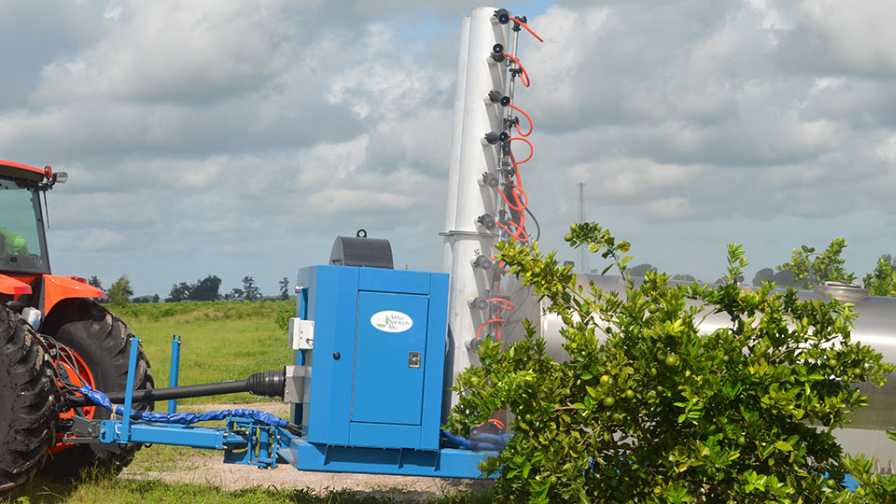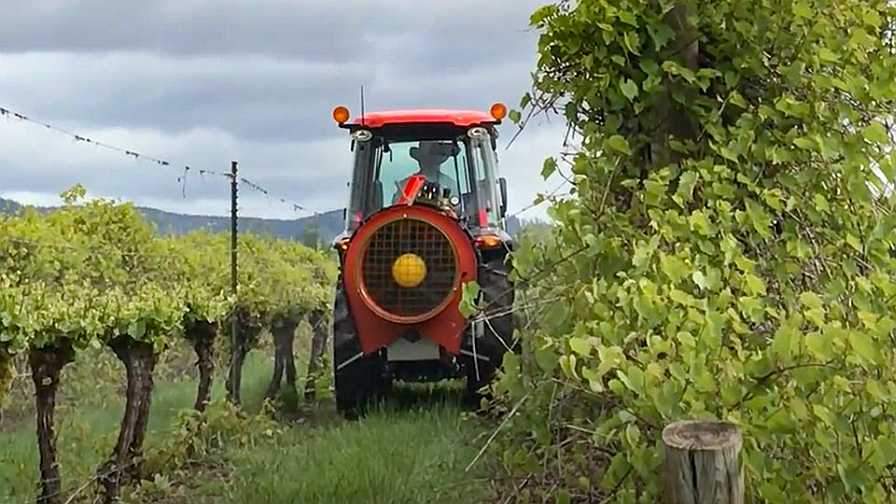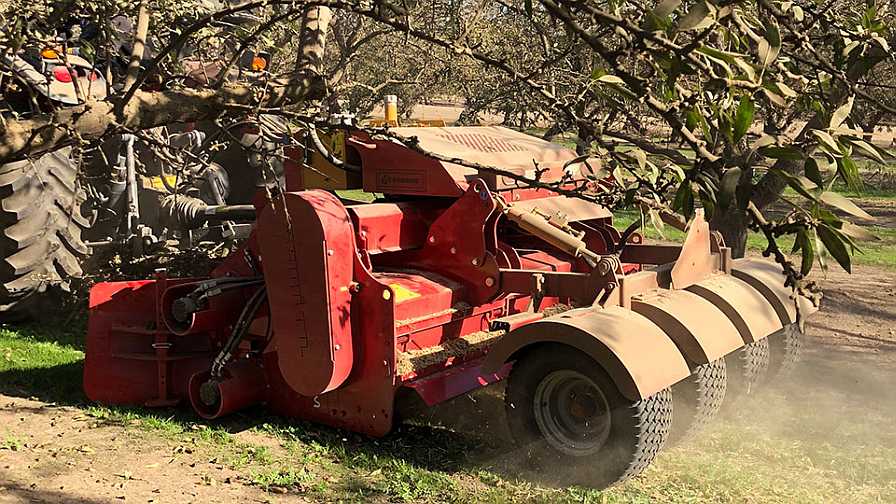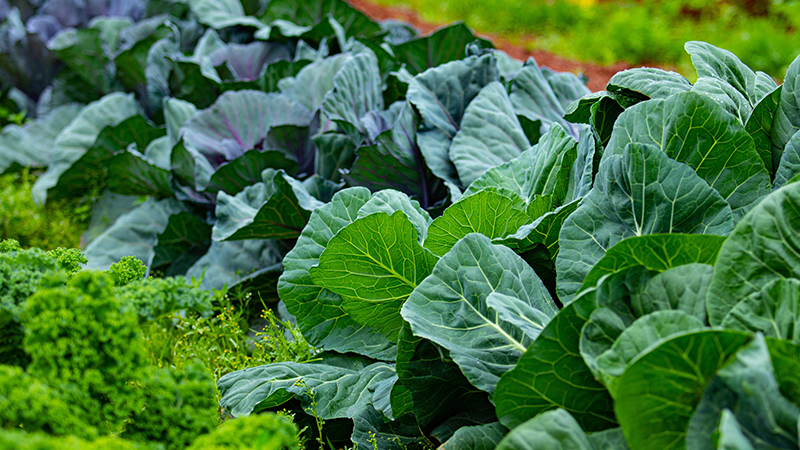Ways Sprayer Tech Is Coming up Fruitful in Orchards

The Airtec Air Boom Tower Sprayer targets the plant canopies with air nozzles rather than blasting from the ground upward like other air blast sprayers, saving on inputs.
Photo courtesy of AirTec Sprayers
The average sprayer found in U.S. orchards, vineyards, and fields is about 20 years old, making the field ripe for advancement. Several companies have accepted the challenge, though they have approached it in different ways. Here’s a look at those technologies, as well as others centered on such problems as orchard waste management.
While fruit growers have overhauled their planting methods in recent decades — such as growing apples on a V-trellis — sprayer technology has not kept pace, says Tim Schaal, CEO of Airtec Sprayers Inc., Winter Haven, FL. Traditional air blast sprayers are not designed to spray evenly in a trellis system, producing drift and waste.
“Airtec’s tower sprayers for orchards and Airtec’s over-the-row air boom for vineyards both improve spray coverage while almost eliminating upward spray drift by targeting the plant canopies with air nozzles rather than blasting from the ground upwards like other air blast sprayers,” Schaal says. “This allows growers to focus on how much product is needed on the plant to solve their pest and disease issues rather than having to over spray with complex calibrations just to achieve coverage because they no longer have to account for the wasted spray material.”
The majority of sprayers are only high volume or low volume, he says, but because Airtec uses targeted air as the carrier of the spray, the volume of spray material is based on what is needed for product efficacy rather than needing additional water volume just to carry the spray particles to the plant canopy.
“We are solely focused on improving coverage while eliminating waste and spray drift,” Schaal says. “Elimination of waste and spray drift inherent with other types of sprayers — create the biggest opportunity growers have to save money and improve their yields.”
Schaal uses an analogy he got from a grower/customer: “Growers focus on the product they’re spraying, the bullets, but they should focus on the artillery, the sprayer,so they can be on target. The product is only as good as the coverage – a sniper is only as good as the gun he’s using.”
SMART SPRAYING
Steve Booher is taking a different approach to the problem of aging sprayers — providing those units with a revolutionary upgrade. The CEO of Smart Guided Systems, Indianapolis, IN, says their Smart-Apply Intelligent Spray Control System is adapted to the grower’s unit, employing LiDAR (Light Detection and Ranging) to scan each plant or tree in front of the sprayer, creating a density map of the target. Algorithms then calculate the exact amount needed.
As the sprayer passes, each spray nozzle becomes its own variable rate sprayer, Booher says, applying just the right amount per nozzle spray zone. “Published research concludes a 47% to 73% reduction of spray consumption with equal or better crop protection,” he says. “This produces a return in investment of one growing season or less for most crops.”

The Smart-Apply Intelligent Spray Control System, which is adapted to the grower’s sprayer, employs LiDAR (Light Detection and Ranging) to scan each plant for accuracy. The system’s return on investment is less than one year for most growers.
Photo courtesy of Smart Guided Systems
Every time the crop is sprayed, the system collects data on tree height, width, density of each tree, total density of each track or grove, and inventories trees by size, he says. This data enables the grower to make better decisions.
The Intelligent Spray Control System is based off a USDA-developed system that was long in development, test, and research centered at Ohio State University.
“We were honored to have been chosen by the USDA to commercialize the Intelligent Spray Control System and take advantage of the 10 years of research and development they put into the system,” he says.
One big advantage to the system is the grower can set it, so the driver of the rig basically just needs to turn it on and go. While currently only available to modify an existing sprayer, Booher says they will soon offer their own sprayer, or a factory-install option for sprayer companies.
“The average sprayer is 20 years old, and they are still built today the same for the most part,” he says. “There’s a real need for a precision ag piece of equipment to offer a better way.”
SOLVING INDUSTRY PROBLEMS
Efficient spraying is also on the minds of wine grape growers these days, especially as the COVID-19 pandemic has spurred them on to further reduce costs, says Myron Strong, Territory Manager for Gearmore in Ripon, CA. The Gearmore Venturi sprayer provides an answer, as the high-capacity mist sprayer from a company called Cima in Italy covers the entire plant with a fine reduced water/chemical mist.
“It provides better coverage with less water, and less chemical,” says Strong. “That’s the name of the game.”
Another advanced technology that will save grape growers on labor is a prepruner from the Collard product line built and developed in the Champagne district of France. The rotating saw blades allow the grower to address the increasing use of the high-wire trellis, Strong says. “Most growers tell us it will take 25% less time than hand pruning,” he says. “Also, every cut will be the same. With human labor, you will have human variability. The machine is ready for work every morning, and you are totally in charge of your pruning — and your pruning costs.”

Developed by Gearmore, this unit grinds up prunings, etc. on the orchard floor so the grower can incorporate the organic matter into the soil.
Photo courtesy of Gearmore
But perhaps the newest technology from Gearmore that excites Strong the most will help California nut growers with all of their tree waste from orchard removal and pruning. It’s become critical because of a state law that bans the burning of orchard waste. Gearmore has worked extensively with the Italian manufacturers, Seppi and Sicma, to develop units that can be used with growers’ tractors to process prunings into a fine mulch and then incorporate them back into the soil for enhanced floor management and water retention.
“Gearmore literally supplies products and works with manufacturers from around the world to help growers mechanize all they can and reduce reliance on labor,” he says. “As we look further out, over the next five years it is imperative that we continue to advance sprayer technology, pruning, wood elimination, and vineyard and orchard floor management to enhance crop production.”
Paul J. Licata is also focusing on orchard waste, through weeds in his case. The owner of BDi Machinery Sales, Inc., Macungie, PA, says organic farming is more popular than ever, and all growers are trying to use fewer herbicides. Licata’s answer is the Rinieri Bio Dynamic. This machine is used in vineyards and orchards, cultivating grass and weeds without harming the plants or the roots. The Bio Dynamic product line is designed for fast weeding with a working speed up to 7 mph.
Jaclyn Bennett, General Manager of Parabug in Salinas, CA believes growers should be looking to the skies for help — help from drones, that is. Parabug is a patents pending mechanism that attaches to a drone to release beneficial insects into a crop as part of an IPM (integrated pest management) program.
“Our technology aims to bring back and increase the use of commercially reared beneficial insects in outdoor cropping systems,” she says. “These ‘good bugs’ are used to control agricultural pests. And by utilizing Parabug at time of release, growers can reduce the human labor inputs and inconsistencies associated with the current industry standard, hand release. Our one-of-a-kind mechanism works with the biology of many beneficial insects to allow for uniform, timely, effective release of beneficial insects directly to the crop canopy — whether it be field, orchard, or vineyard crops — while saving growers 50% to 75% on their application costs.”









